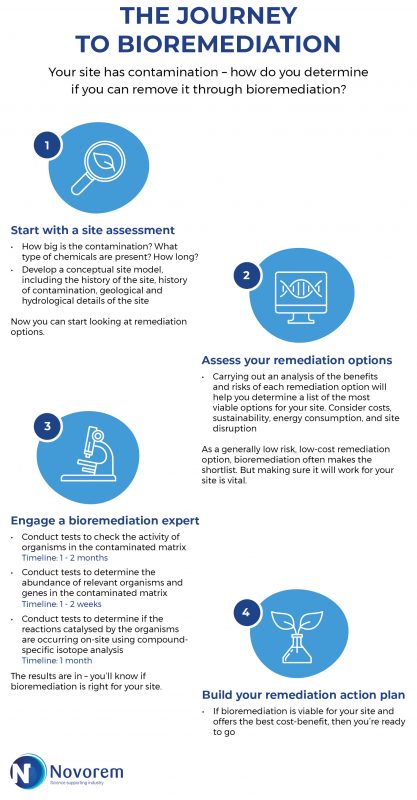The way remediation is approached has begun to change, with once-standard ‘dig and dump’ or ‘pump and treat’ methods no longer always the go-to option.
Remediation is becoming more varied and more analysis driven. Surveying the options within a risk framework for the best method for each individual project in regard to effectiveness, disruption, cost and more is now the way forward.
You’ll be familiar with some of the processes involved in preparing for remediation, but many people are still in the dark about bioremediation, and how it fits into their remediation plan.
Bioremediation is gaining popularity due to its environmental and sustainability advantages, as well as lower cost and disruption.
These factors alone, however, are not enough to proceed with bioremediation as your chosen option – site viability needs to be established first. And that takes expert work.
Having an understanding on how and when bioremediation testing fits into your overall remediation analysis can put you in a better place to build a more effective action plan.
The more you know, the less you risk
While knowing the precise ins and outs of bioremediation isn’t completely necessary for utilising the technology (and would likely take you several years of study), knowing the steps, the time and the process is helpful.
Without a good understanding of what is required to include bioremediation into your assessment and action plan, you’ll likely either over or under-estimate the possibility of it being a relevant option for your site.
The fact that it is relatively new and can be hard to get your head around (without a strong background in chemistry and biology), makes it easy to make assumptions that are incorrect.
Some of the common misconceptions include:
- it’s too difficult;
- it takes too long;
- it’s more expensive than traditional methods;
- it’s easier or quicker than it really is;
- it will always work
Bioremediation takes some preparation and planning for. Without understanding the parameters around this, you’ll likely find yourself wasting time and money on the wrong techniques.
But if you can get bioremediation right, the environmental, social and financial benefits can be significant.
How it all comes together
By understanding what goes into bioremediation and how it can fit into your overall remediation assessment, you could save yourself a lot of time, money and effort.
We’ve made it simple with an easy, step-by-step chart. It’ll show you not only how and where it fits into your assessment, but the testing that needs to be undertaken (and the time it takes to do so).

As you can see, it’s important to get expert analysis before building your action plan and determining the cost vs. benefit of your remediation options.
Step three is the most important in the journey to bioremediation, as it defines your sites viability with contaminant-feeding biomes. It’s also the step where Novorem’s expertise comes in.
Novorem are the only Australian owned company with world class expertise in bioremediation. We can provide all the testing services outlined in Step three that give you an in-depth understanding of your site and its contaminants. Novorem can put you on the path to bioremediation and achieve a more sustainable and cost-effective clean-up.
If you’d like more information about bioremediation, or about the testing and assessment required, click here to contact Novorem.
Author bio:
Önder Kimyon is the principal scientist of Novorem Pty Ltd and is a renowned expert in environmental science and microbiology.
Önder and the Novorem Team have made award winning contributions to environmental research and biotechnology development, including the biological degradation of contaminants of concern.
If you would like to know more about microbiology or bioremediation, click here to contact Önder.


